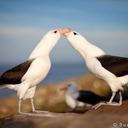To find out more about the Royal Albatross, visit our link!
The albatross is considered to have the largest wingspan of all birds. It’s wingspan can reach up to 3.5 meters (11.5 ft) and is a great advantage when flying long distances.

To find out more about the Royal Albatross, visit our link!
Five of the twenty-one species of albatross birds, in which nineteen are threatened.
2a. Southern Royal Albatross (Diomedea epomophora epomophora)
2b. Southern Royal Albatross
2c. Royal Albatross (Diomedea epomophora)
2d. Southern Royal Albatross
2e. Northern Royal Albatross (Diomedea epomophora sandfordi)
http://nzetc.victoria.ac.nz/tm/scholarly/tei-Bio21Tuat01-02-t1-back-d2.html
The Difference Between Bird & Human Vision
Avian and Mammalian eyes both have their similarities and differences from one another. For instance, the location of the eye on the skull of both species differs as well as the shape of the eye. Moreover, the eyes of humans have a spherical shape while the eyes of avian species have a flatter shape that assists in focusing images perceived in the visual field. The eyes of the Royal Albatross are positioned sideways in the front of the the skull, although they are large enough to see forwards and sideways. This benefits albatross birds because the location of their eye causes their binocular vision to overlap with their monocular vision, allowing the bird to precisely determine the distance ahead of it. Since the eye is located in the side and front of the head, the Royal Albatross has a wide visual field, which is a great advantage for finding predators, and a clear and detailed binocular vision, which is beneficial for calculating the distance when hunting. Unlike birds, all humans’ eyes are located on the front of their skull, faced forwards.
It is a known fact that both species have lens that carry the same functions. Although, the lens in avian eyes can adjust to various distance quicker than those of humans and can focus clearly to a greater extent. Both eyes consist of two types of photo receptors–rods and cones. Although, some birds have four types of color receptors. One of the four receptors gives birds the ability to see clearly at a greater range, others allow birds to see UV light and much more. In general, birds have more light receptors and nerve connections than humans. Each cone in a bird’s eye contains yellow or red oil droplets that improve a bird’s awareness of distance and vision. These droplets function as a filter and increase the number of colors a bird can perceive. Unlike birds, humans only have 6 million cone sells, which limits the amount of colors they can see. One major drawback for birds is that they can not move their eyes, instead, they have to tilt their head to see. As for humans, they are able to move their eyes up and down, and back and forth. Both species have their advantages and disadvantages, although they both possess the necessary attributes that fit their lifestyle.
http://en.wikipedia.org/wiki/Bird_vision
It is a beautiful area for albatross, on a protected ridge overlooking the ocean with trade winds needed for their first flight in a few months.
Great albatross!–the meanest birds Spring up and flit away, While thou must toil to gain a flight, And spread those pinions grey; But when they once are fairly poised, Far o'er each chirping thing Thou sailest wide to other lands, E'en sleeping on the wing.
Avian Eye Anatomy
The eye structure of Avian species resemble and differ from eye structures of mammalian species. For instance, both species have the same main components in the eye that share the same functions, although some might differ in number. In the avian eye, the outermost layer of the eye comprises of the cornea and two layers of the sclera. The eye is separated into two main parts: the anterior segment and the posterior segment. The anterior chamber consists of the aqueous humor while the posterior chamber contains the virtuous humor.
In avian species, the lens has the same function as those of mammalian species, which is to focus the incoming light on the retina. Moreover, not only do ciliary muscles adjust the shape of the lens, but they adjust the shape of the cornea to help birds have a greater field of vision. Since vision is essential for birds, 54% of birds, including birds of prey, have two foveae, which improves lateral vision. The optic nerve then carries the messages from the eye to the brain for interpretation.
The pecten oculi and choroid is a unique structure only found in birds. The pecten continues to provide the retina with nutrients, protects the retina from inclement light, and assists in detecting moving objects. Since the pecten oculi and choroid are both filled with melanin, they prevent background glare. The choroid, which is a layer located in the back of the retina, provides arterial blood (oxygenated blood) to the retina and removes less oxygenated blood.
The albatross is considered to have the largest wingspan of all birds. It’s wingspan can reach up to 3.5 meters (11.5 ft) and is a great advantage when flying long distances.
#Albatross, or Feathered Giants, can reach a wingspan of 11ft, gliding the ocean winds for hours without rest. Northern Royal Albatross, Seaward Kaikoura Range. Photo by Niklas Holmström
Source: ashleychildsstudio
The northern royal albatross is a bird that resides in tufts of vegetation along oceanside cliffs in the Chatham Islands of New Zealand. He is very sizeable for a bird, and has feathers predominately colored the purest of whites. This particular species takes nearly eight years before they ever...
Source: teraczy